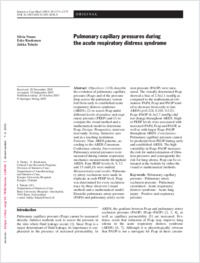Pulmonary capillary pressures during the acute respiratory distress syndrome.
- Nunes S Critical Care Research Program, Division of Intensive Care, Department of Anesthesiology and Intensive Care , Kuopio University Hospital, Kuopio, Finland.
- Ruokonen E Critical Care Research Program, Division of Intensive Care, Department of Anesthesiology and Intensive Care , Kuopio University Hospital, Kuopio, Finland.
- Takala J Department of Intensive Care, Bern University Hospital-Inselspital, 3010 , Bern, Switzerland. Jukka.Takala@insel.ch.
- 2003-10-31
Published in:
- Intensive care medicine. - 2003
Adolescent
Adult
Aged
Female
Humans
Intensive Care Units
Linear Models
Male
Middle Aged
Positive-Pressure Respiration
Prospective Studies
Pulmonary Wedge Pressure
Respiratory Distress Syndrome, Adult
English
OBJECTIVES
(1). To describe the evolution of pulmonary capillary pressure (Pcap) and of the pressure drop across the pulmonary venous bed from early to established acute respiratory distress syndrome (ARDS), (2). to assess Pcap under different levels of positive end-expiratory pressure (PEEP) and (3). to compare the visual method and a mathematical model to determine Pcap.
DESIGN
Prospective, intervention study.
SETTING
Intensive care unit in a teaching institution.
PATIENTS
Nine ARDS patients, according to the ARDS Consensus Conference criteria.
INTERVENTIONS
Pulmonary arterial pressures were measured during routine respiratory mechanics measurements throughout ARDS. Four PEEP levels (6, 9, 12 and 15 cmH(2)O) were studied.
MEASUREMENTS AND RESULTS
Pulmonary artery occlusions were made in triplicate at each PEEP level. Pcap was determined for every occlusion trace by three observers (visual method) and a mathematical model. Diastolic pulmonary artery pressure (PAPd) and pulmonary artery occlusion pressure (PAOP) were measured. The visually determined Pcap showed a bias of 2.5+/-2.1 mmHg as compared to the mathematical estimation. PAPd, Pcap and PAOP tended to decrease from early to late ARDS ( p=0.128, 0.265, 0.121). Pcap-PAOP (6.3+/-2.7 mmHg) did not change throughout ARDS. Higher PEEP levels were associated with increased PAPd, Pcap and PAOP, as well as with larger Pcap-PAOP throughout ARDS.
CONCLUSIONS
Pulmonary capillary pressure cannot be predicted from PAOP during early and established ARDS. The high variability in Pcap-PAOP increases the risk for underestimation of filtration pressures and consequently the risk for lung edema. Pcap can be estimated at the bedside by either the visual or mathematical methods.
(1). To describe the evolution of pulmonary capillary pressure (Pcap) and of the pressure drop across the pulmonary venous bed from early to established acute respiratory distress syndrome (ARDS), (2). to assess Pcap under different levels of positive end-expiratory pressure (PEEP) and (3). to compare the visual method and a mathematical model to determine Pcap.
DESIGN
Prospective, intervention study.
SETTING
Intensive care unit in a teaching institution.
PATIENTS
Nine ARDS patients, according to the ARDS Consensus Conference criteria.
INTERVENTIONS
Pulmonary arterial pressures were measured during routine respiratory mechanics measurements throughout ARDS. Four PEEP levels (6, 9, 12 and 15 cmH(2)O) were studied.
MEASUREMENTS AND RESULTS
Pulmonary artery occlusions were made in triplicate at each PEEP level. Pcap was determined for every occlusion trace by three observers (visual method) and a mathematical model. Diastolic pulmonary artery pressure (PAPd) and pulmonary artery occlusion pressure (PAOP) were measured. The visually determined Pcap showed a bias of 2.5+/-2.1 mmHg as compared to the mathematical estimation. PAPd, Pcap and PAOP tended to decrease from early to late ARDS ( p=0.128, 0.265, 0.121). Pcap-PAOP (6.3+/-2.7 mmHg) did not change throughout ARDS. Higher PEEP levels were associated with increased PAPd, Pcap and PAOP, as well as with larger Pcap-PAOP throughout ARDS.
CONCLUSIONS
Pulmonary capillary pressure cannot be predicted from PAOP during early and established ARDS. The high variability in Pcap-PAOP increases the risk for underestimation of filtration pressures and consequently the risk for lung edema. Pcap can be estimated at the bedside by either the visual or mathematical methods.
- Language
-
- English
- Open access status
- green
- Identifiers
-
- DOI 10.1007/s00134-003-2036-0
- PMID 14586495
- Persistent URL
- https://susi.usi.ch/global/documents/172295
Statistics
Document views: 12
File downloads:
- fulltext.pdf: 0
